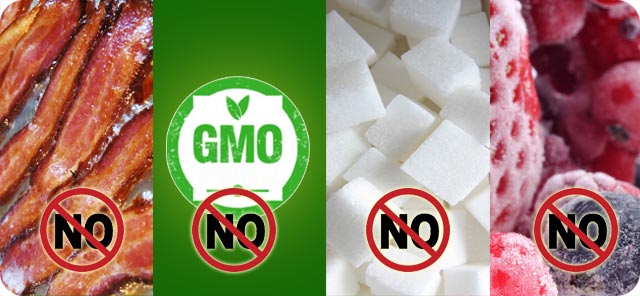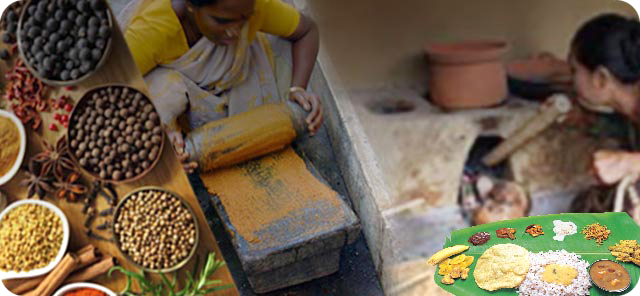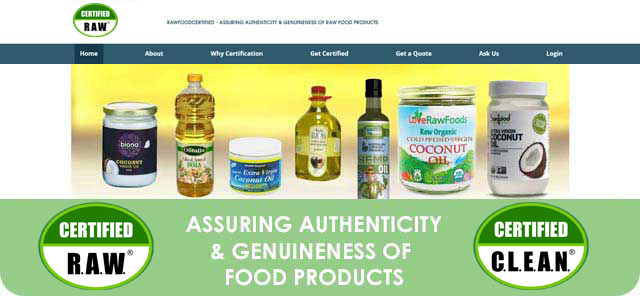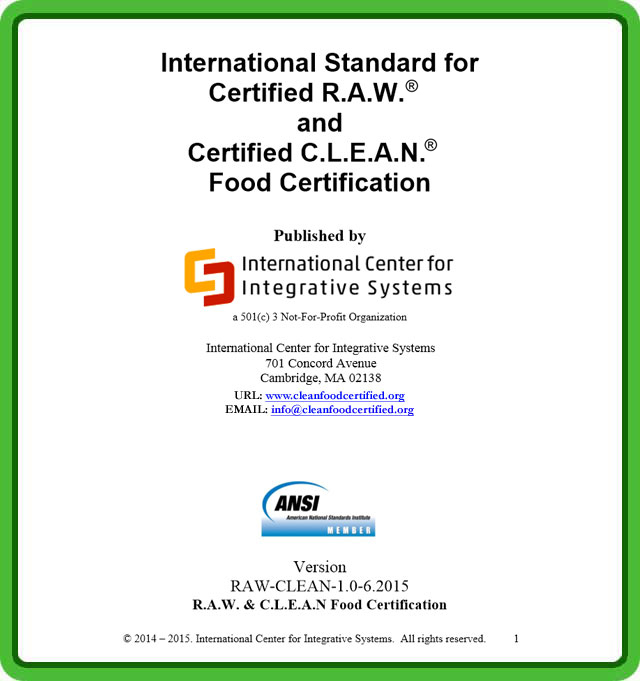What is C.L.E.A.N. and R.A.W.?
The confusion on what is “good” and “clean” food
 Starting the early 1990’s, raw food gurus emerged, leading what is now known as the Raw Food Movement. These gurus, with perhaps sincerest intentions, created this movement to foster a more healthy approach to eating food in their natural state.
Starting the early 1990’s, raw food gurus emerged, leading what is now known as the Raw Food Movement. These gurus, with perhaps sincerest intentions, created this movement to foster a more healthy approach to eating food in their natural state.
Over the past 20 years, some aspects of this movement became more cult-like and “religious”, moving away from their original intentions to help the consumer, and placing it more on the personality of the gurus themselves.
Many new products, educational seminars, conferences etc. resulted from this growing movement. Based on some reports, the raw food movement is nearly a half-billion dollar industry today.
As the industry has grown, and new products appeared on shelf, retailers such as Whole Foods Market have become concerned on the safety of raw food products, and understanding what is raw food. Such concerns and questions reveal an underlying conclusion on not only what is “raw” but also what is “good” and “clean” food.
An opportunity to understand what is “good” and “clean” food
 We all know the adage Let Thy Food Be Thy Medicine. The confusion emerging from understanding what is “raw” food provides a broader opportunity to define what good food is.
We all know the adage Let Thy Food Be Thy Medicine. The confusion emerging from understanding what is “raw” food provides a broader opportunity to define what good food is.
We have been told, far too many times, what kind of food is “bad”. But rarely are we told what is good food. We’re told not to eat too much fat, sugar is bad, stay away from chemicals and pesticides etc., but what is good food? What is clean food? What is raw food? Is there a systematic and scientific way where we can identify what is good food?
Indigenous and traditional cultures knew what was good food
 After many millennia of trial and error, indigenous and traditional cultures had a profound sense of what was good food. They knew how to combine food, when to eat food, and how to process food so our bodies received the optimal nutrition.
After many millennia of trial and error, indigenous and traditional cultures had a profound sense of what was good food. They knew how to combine food, when to eat food, and how to process food so our bodies received the optimal nutrition.
These cultures recognized that food had multiple purposes:
1.To deliver the nutrition for the individual’s particular constitution
2.To be pleasurable to eat and give joy, and
3.To build a sense of community as gathering, processing and eating food was a communal activity.
This is what food was about.
People in indigenous and traditional cultures did not have to worry about GMOs, since everything was organic and bio-dynamic. They didn’t have to worry about not eating too much fat, or salt, because they were in touch with their bodies and connected to the earth.
Their food was, by its very nature, real, alive and whole. By real, it meant that the food was prepared in a safe manner and was not engineered or filled with pesticides. By alive, it meant the food had good enzymes to support digestion. By whole, it meant the food was minimally processed and was nutrient-dense.
Another way they thought about their food was that it needed to be: conscious, live, ethical, bio-active, and nutritious. By conscious, they paid attention to the entire process of gathering, producing and digesting food. By live, they focused on processing methods that did not “kill” the food, by using excessive temperatures. By ethical, they expressed a deep reverence for nature, and the process of using the resources in their environment. By bio-active, they were deeply concerned with ensuring that the food was “active” with the gut and our own internal bacteria. Nutrition meant that they chose high quality nutrient dense ingredients.
The truth is indigenous and traditional cultures knew what was good and clean food.
Rediscovering Good Food – Certified R.A.W.®/Certified C.L.E.A.N.®
 In early 2014, given growing pressures from regulatory agencies as well as retailers and consumers, leaders of the raw food community recognized that the confusion around raw food could detrimentally affect their businesses. There needed to be a more formal definition of what raw food is.
In early 2014, given growing pressures from regulatory agencies as well as retailers and consumers, leaders of the raw food community recognized that the confusion around raw food could detrimentally affect their businesses. There needed to be a more formal definition of what raw food is.
Leaders of the raw food community including Brad’s Raw Foods, Alive & Radiant, Rawone, Living Intentions and Go Raw, shared with Dr. V.A. Shiva Ayyadurai, the inventor of email and MIT-trained systems scientist, the problems they were facing. Dr. Ayyadurai, also a one-time raw-foodist, agreed to volunteer his expertise in food and nutrition science, systems theory, systems biology as well as standards development to facilitate the development of an international standard for defining and certifying raw food products through the International Center for Integrative Systems.
Prior to 2014, there was a great deal of confusion on what was raw. In fact, there was no clear definition at all of what was raw. There was at best a “religious” viewpoint that raw meant any food that was not cooked above 114 degrees. Beyond this definition it was nebulous and filled with hand-waving.
Given this nebulous definition and growing concerns of the safety of raw food, the scientific community, health care workers and retailers had serious concerns. Moreover, few were willing to really take the time to understand and appreciate the benefits of raw food and its empirical benefits, given this confusion. Dr. V.A. Shiva Ayyadurai, who holds four degrees from MIT, including his Ph.D. from the Department of Biological Engineering (originally the Food and Nutrition Science Department), organized a series of teleconferences, meetings, public hearings and led the drafting of the international standard for raw food. His scientific approach to this problem blended his training in eastern medicine, traditional foods, experiences from his indigenous culture growing up in India as well as his western training in engineering and medicine to develop this standard.
What emerged was one standard which helped not only the raw food community clear confusion and define what is raw food – as food that is Real, Alive and Whole in congruence with principles of the indigenous cultures and formalized and systematized within the western scientific framework – but also a broader standard for all food manufacturers to help them distinguish themselves as those committed to creating food that is Conscious, Live, Ethical, Active and Nourishing.
This single standard can be used by raw food manufacturers to distinguish their products with the Certified R.A.W. imprimatur as well as all food manufacturers (including raw food manufacturers) to distinguish their products with the Certified C.L.E.A.N. imprimatur.
Certified R.A.W. and Certified C.L.E.A.N. Defined what is Good Food
Ayyadurai’s efforts, in conjunction with the discourse with the raw food community such as the Whole Foods Market, has now led to an International Standard for Raw Food Certification and the imprimaturs Certified R.A.W.® and Certified C.L.E.A.N.®
The International Center for Integrative Systems, a 501 (C) Non Profit Organization, is the home of the RawFoodCertified.org project and the Cleanfoodcertified.org projects. It also provides the infrastructure, administration and governance to certify products using the international standard.
For products to be Certified R.A.W.:
- They must be “Real.” The Real element was captured by the criteria that the product must be 100% safe (for a score of 0 or 25) and must have all non-GMO ingredients (for a score of 0 or 25), for a total score of 0 or 25 or 50.
- They must be “Alive.” The notion of Alive was denoted by the level of bioavailability of the combination of ingredients in the product, determined using a bioinformatics approach currently accessible through the CytoSolve technology. Score for this aspect can range from 0 to 20.
- They must be “Whole.” The element of Whole was captured by two criteria:
- The level of organic ingredients that can get a score from 0 to 20, and
- the ANDI nutrient score of the combination of ingredients normalized between 0 and 10.
For products to be Certified C.L.E.A.N.:
- They must be “Conscious.” The Conscious element was captured by the criteria that the product must be 100% safe (for a score of 0 or 25.)
- They must be “Live,” which means a majority of the ingredients must be organic, to fetch a score between 0 and 20.
- They must be “Ethical” in the sense that the ingredients must be 100% non-GMO (for a score of 0 or 25.)
- They must be “Active.” The notion of Active was denoted by the level of bioavailability of the combination of ingredients in the product, determined using a bioinformatics approach currently accessible through the CytoSolve technology. Score for this aspect can range from 0 to 20.
- They must be “Nourishing,” as determined by ANDI nutrient score of the combination of ingredients, normalized between 0 and 10.
In short, these certifications are like going back to the future to help us define what good food is. The standard, in many ways, is based on the teachings of indigenous and traditional cultures and is bringing those teachings back to the modern world.
Whether you are a consumer, manufacturer, retailer or someone who is interested in health, learning about these certifications is going to help you create a healthier world for you, your family and your community.
Free 1-Hour Consultation
Please submit the form below to download the international standard documents for Certified C.L.E.A.N. & Certified R.A.W. And, if you are a food manufacturer, you can get a free 1 hour consultation so you can understand in detail about the background, cost, benefits and process of of getting Certified R.A.W./Certified C.L.E.A.N.



